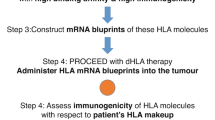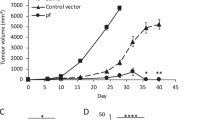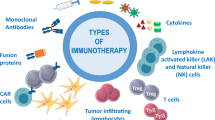Abstract
The development of the monoclonal antibody technique1 has led to renewed interest in whether the growth of tumour cells may be specifically inhibited by antibodies or antibody–toxin conjugates directed against antigenic determinants selectively expressed on tumour cells2–10. We have recently obtained monoclonal antibodies against the transferrin receptor of human cells11,12, which is thought to have an essential role in transport of Fe across the cell membrane and which is selectively expressed on proliferating cells in vivo and in vitro13–17. In some cases, transferrin receptors can be used as a marker to distinguish between tumour cells and normal tissue11,15–17. Here we show that human tumour cells are specifically killed in vitro by anti-transferrin receptor antibody covalently coupled to ricin or diphtheria toxic subunits. In experiments designed to test the effectiveness of these antibody–toxin conjugates in vivo, we found that anti-transferrin receptor antibody alone inhibits the growth of human melanoma cells in nude mice.
This is a preview of subscription content, access via your institution
Access options
Subscribe to this journal
Receive 51 print issues and online access
$199.00 per year
only $3.90 per issue
Buy this article
- Purchase on Springer Link
- Instant access to full article PDF
Prices may be subject to local taxes which are calculated during checkout
Similar content being viewed by others
References
Köhler, G. & Milstein, C. Nature 256, 495–497 (1975).
Gilliland, D. G. et al. Proc. natn. Acad. Sci. U.S.A. 77, 4539–4543 (1980).
Krolick, K. A., Villemez, C., Isakson, P., Uhr, J. W. & Vitetta, E. S. Proc. natn. Acad. Sci. U.S.A. 77, 5419–5423 (1980).
Youle, R. J. & Neville, D. M. Proc. natn. Acad. Sci. U.S.A. 77, 5483–5486 (1980).
Bernstein, I. D., Tam, M. R. & Nowinski, R. C. Science 207, 68–71 (1980).
Nadler, L. M. et al. Cancer Res. 40, 3147–3154 (1980).
Blythman, H. E. et al. Nature 290, 145–146 (1981).
Davies, T. Nature 289, 12–13 (1981).
Miller, R. A., Maloney, D. G., McKillop, J. & Levey, R. Blood 58, 79–86 (1981).
Ritz, J. et al. Blood 58, 141–151 (1981).
Omary, M. B., Trowbridge, I. S. & Minowada, J. M. Nature 286, 888–891 (1980).
Trowbridge, I. S. & Omary, M. B. Proc. natn. Acad. Sci. U.S.A. 78, 3039–3043 (1981).
Larrick, J. W. & Creswell, P. G. J. supramolec. Struct. 11, 579–586 (1980).
Hamilton, T. A., Wada, H. G. & Sussman, H. H. Proc. natn. Acad. Sci. U.S.A. 76, 6406–6410 (1979).
Faulk, W. P., Hsi, B.-L. & Stevens, P. J. Lancet ii, 390–392 (1980).
Shindelman, J. E., Ortmeyer, A. E. & Sussman, H. H. Int. J. Cancer 27, 329–334 (1981).
Sutherland, R. et al. Proc. natn. Acad. Sci. U.S.A. 78, 4515–4519 (1981).
Olsnes, S. & Pihl, A. Biochemistry 12, 3121–3126 (1973).
Kandel, J., Collier, R. J. & Chung, S. W. J. biol. Chem. 249, 2088–2097 (1974).
Carlsson, J., Drevin, H. & Axen, R. Biochem. J. 173, 723–737 (1978).
Foley, G. E. et al. Cancer 18, 522–529 (1965).
Imai, K., Molinaro, G. A. & Ferrone, S. Transplantn Proc. 12, 380–383 (1980).
Old, L., Stockert, E., Boyse, E. & Kim, J. H. J. exp. Med. 127, 523–539 (1968).
Hyman, R., Cunningham, K. & Stallings, V. Immunogenetics 10, 261–271 (1980).
Sullivan, A. L., Grasso, J. A. & Weintraub, L. R. Blood 47, 133–143 (1976).
Octave, J. N., Schneider, Y.-J., Crichton, R. R. & Trouet, A. Eur. J. Biochem. 115, 611–618 (1981).
Greaves, M. & Janossy, G. Biochim. biophys. Acta 516, 193–230 (1978).
Brown, J. P. et al. Proc. natn. Acad. Sci. U.S.A. 78, 539–543 (1981).
Metzgar, R. S., Borowitz, M. J., Jones, N. H. & Dowell, B. L. J. exp. Med. 154, 1249–1254 (1981).
Bramwell, M. E. & Harris, H. Proc. R. Soc. B201, 87–106 (1978).
Bramwell, M. E. & Harris, H. Proc. R. Soc. B203, 93–99 (1979).
Author information
Authors and Affiliations
Rights and permissions
About this article
Cite this article
Trowbridge, I., Domingo, D. Anti-transferrin receptor monoclonal antibody and toxin–antibody conjugates affect growth of human tumour cells. Nature 294, 171–173 (1981). https://doi.org/10.1038/294171a0
Received:
Accepted:
Issue Date:
DOI: https://doi.org/10.1038/294171a0
This article is cited by
-
Transferrin Receptor-Mediated Endocytosis: A Useful Target for Cancer Therapy
The Journal of Membrane Biology (2014)
-
A novel transferrin receptor-targeted hybrid peptide disintegrates cancer cell membrane to induce rapid killing of cancer cells
BMC Cancer (2011)
-
Study on molecular interactions between proteins on live cell membranes using quantum dot-based fluorescence resonance energy transfer
Analytical and Bioanalytical Chemistry (2008)
Comments
By submitting a comment you agree to abide by our Terms and Community Guidelines. If you find something abusive or that does not comply with our terms or guidelines please flag it as inappropriate.



